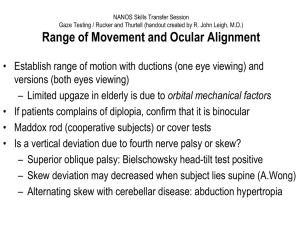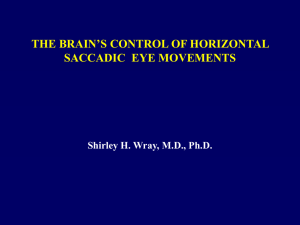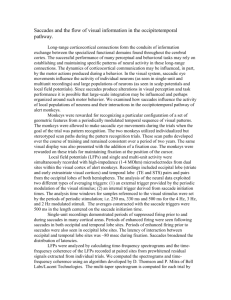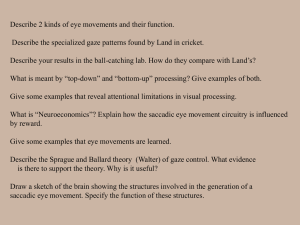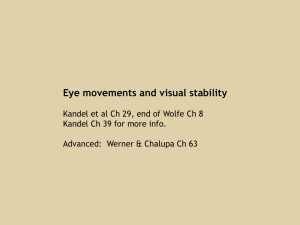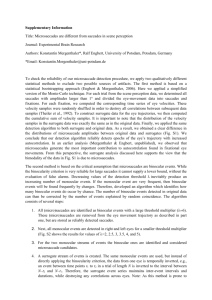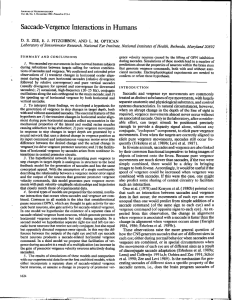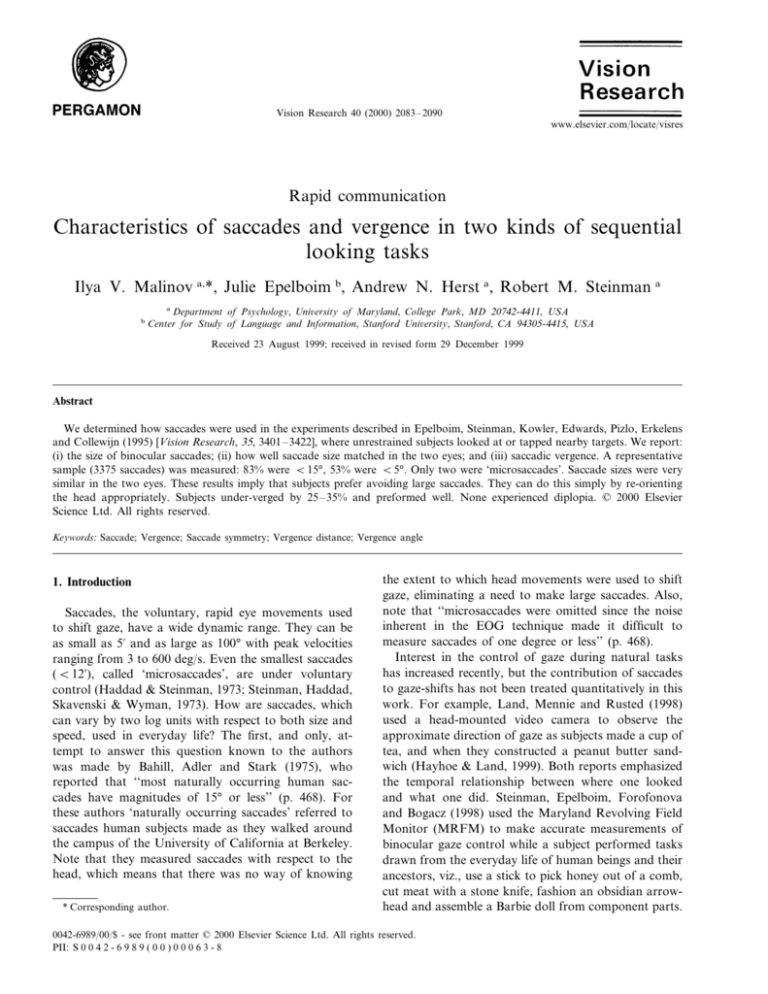
Vision Research 40 (2000) 2083 – 2090
www.elsevier.com/locate/visres
Rapid communication
Characteristics of saccades and vergence in two kinds of sequential
looking tasks
Ilya V. Malinov a,*, Julie Epelboim b, Andrew N. Herst a, Robert M. Steinman a
b
a
Department of Psychology, Uni6ersity of Maryland, College Park, MD 20742 -4411, USA
Center for Study of Language and Information, Stanford Uni6ersity, Stanford, CA 94305 -4415, USA
Received 23 August 1999; received in revised form 29 December 1999
Abstract
We determined how saccades were used in the experiments described in Epelboim, Steinman, Kowler, Edwards, Pizlo, Erkelens
and Collewijn (1995) [Vision Research, 35, 3401–3422], where unrestrained subjects looked at or tapped nearby targets. We report:
(i) the size of binocular saccades; (ii) how well saccade size matched in the two eyes; and (iii) saccadic vergence. A representative
sample (3375 saccades) was measured: 83% were B15°, 53% were B5°. Only two were ‘microsaccades’. Saccade sizes were very
similar in the two eyes. These results imply that subjects prefer avoiding large saccades. They can do this simply by re-orienting
the head appropriately. Subjects under-verged by 25– 35% and preformed well. None experienced diplopia. © 2000 Elsevier
Science Ltd. All rights reserved.
Keywords: Saccade; Vergence; Saccade symmetry; Vergence distance; Vergence angle
1. Introduction
Saccades, the voluntary, rapid eye movements used
to shift gaze, have a wide dynamic range. They can be
as small as 5% and as large as 100° with peak velocities
ranging from 3 to 600 deg/s. Even the smallest saccades
( B 12%), called ‘microsaccades’, are under voluntary
control (Haddad & Steinman, 1973; Steinman, Haddad,
Skavenski & Wyman, 1973). How are saccades, which
can vary by two log units with respect to both size and
speed, used in everyday life? The first, and only, attempt to answer this question known to the authors
was made by Bahill, Adler and Stark (1975), who
reported that ‘‘most naturally occurring human saccades have magnitudes of 15° or less’’ (p. 468). For
these authors ‘naturally occurring saccades’ referred to
saccades human subjects made as they walked around
the campus of the University of California at Berkeley.
Note that they measured saccades with respect to the
head, which means that there was no way of knowing
* Corresponding author.
the extent to which head movements were used to shift
gaze, eliminating a need to make large saccades. Also,
note that ‘‘microsaccades were omitted since the noise
inherent in the EOG technique made it difficult to
measure saccades of one degree or less’’ (p. 468).
Interest in the control of gaze during natural tasks
has increased recently, but the contribution of saccades
to gaze-shifts has not been treated quantitatively in this
work. For example, Land, Mennie and Rusted (1998)
used a head-mounted video camera to observe the
approximate direction of gaze as subjects made a cup of
tea, and when they constructed a peanut butter sandwich (Hayhoe & Land, 1999). Both reports emphasized
the temporal relationship between where one looked
and what one did. Steinman, Epelboim, Forofonova
and Bogacz (1998) used the Maryland Revolving Field
Monitor (MRFM) to make accurate measurements of
binocular gaze control while a subject performed tasks
drawn from the everyday life of human beings and their
ancestors, viz., use a stick to pick honey out of a comb,
cut meat with a stone knife, fashion an obsidian arrowhead and assemble a Barbie doll from component parts.
0042-6989/00/$ - see front matter © 2000 Elsevier Science Ltd. All rights reserved.
PII: S 0 0 4 2 - 6 9 8 9 ( 0 0 ) 0 0 0 6 3 - 8
2084
I.V. Malino6 et al. / Vision Research 40 (2000) 2083–2090
This report emphasized the control of vergence and the
accuracy of cyclopean gaze under natural conditions.
The nature of saccades, as such, was not described.
The present paper begins to fill this gap. It describes:
(i) the size of binocular saccades; (ii) how well saccades
size matched in the two eyes; and (iii) saccadic vergence
under naturalistic conditions.
2. Methods
2.1. Database
This paper reports the results of additional analyses
of data collected with the Maryland Revolving Field
Monitor (MRFM) that led to three publications, viz.,
Epelboim, Steinman, Kowler, Edwards, Pizlo, Erkelens
et al. (1995), Epelboim, Steinman, Kowler, Edwards,
Pizlo, Erkelens et al. (1997) and Epelboim (1998). These
publications dealt with the control of gaze (the line-ofsight in spatial coordinates). They described: (i) visual
search, gaze-shift accuracy and the function of gazeshifts; (ii) gaze-shift dynamics; and (iii) gaze and retinal-image-stability in two kinds of sequential looking
tasks performed under naturalistic conditions. Tasks
were naturalistic in the sense that the head and torso
were free to move.
2.2. Sampling procedure
A representative sample of binocular eye/head movement trials described in Epelboim et al. (1995) was
analyzed. Trials were randomly-sampled within subjects
(four), tasks (two), number of targets (three) and replications (ten). The two tasks were: (i) look at a sequence
of 2, 4 or 6 targets (LOOK) or (ii) tap a similar
sequence (TAP). The angular separation of targets was
random, varying between about 1.5° and 35° of visual
angle. The distance from the subjects’ eyes to the
targets varied from about 50 to 90 cm, depending on
where the targets were and how much each seated
subject moved.
2.3. Apparatus
The MRFM, which records binocular gaze accurately with the head and torso free, was described in
Edwards, Pizlo, Erkelens, Collewijn, Epelboim, Kowler
et al. (1994) and summarized in the papers just cited.
Only specifications will be provided. The MRFM consists of three subsystems: (1) A revolving-magnetic-field
monitor/sensor coil subsystem using phase-detection to
measure angular eye and head positions (angle precision=1%, linearity =0.01%). Data were acquired at 976
Hz, successive sample-pairs averaged and stored at 488
Hz. Cube-surface field coils (2.14 m on a side), pro-
duced a spatially homogeneous magnetic field throughout a large fraction ( 1 m3) of the cube’s volume.
SKALAR-DELFT sensor-coils measured horizontal
and vertical eye-angles. Head roll-, pitch- and yaw-angles were measured with two orthogonal coils mounted
on the head with velcro straps. (2) A sparker tracking
subsystem measured 3-D translations of the head by
detecting the arrival time of acoustic signals generated
by a ‘sparker’ mounted on the head: Translation precision= 0.2 mm, accuracy 1 mm. (3) A worktable (91
cm wide× 67 cm deep× 72 cm high) provided a platform for the targets. Its surface contained an 11×14
grid of 154 wells separated by 4.5 cm. Rods, inserted
into these wells, were topped with different colored
LEDs that served as targets. Targets were turned on
before the trial began, and remained stationary and
visible throughout the trial in a well illuminated room.
2.4. Calibrations
The phase-detection principle used in the MRFM
allows absolute calibration of angles. Two calibrations
were performed at the start of each session with the
head in a known position on a biteboard to determine
the zero-reference for each sensor coil because their
position varies across sessions. Each sensor-coils’ orientation, relative to the line-of-sight, was determined
when the subject fixated each eye’s pupil (seen monocularly) in a mirror parallel to the back edge of the
worktable. The head coils’ zero-references were determined when the XYZ head-position was indicated by
the sparker with the head on a biteboard. Two additional calibrations were performed once: (i) sparkers of
different heights, placed in 18 locations on the worktable, calibrated ‘sparker-space’ and (ii) the sightingcenters of each subject’s eyes were measured
psychophysically with the head on a bite-board.
2.5. Saccade measurement and analysis
Saccades were detected manually with a mouse on a
graphic display of the data. Why? We anticipated measuring saccade amplitudes ranging from 5% to 100°. We
had saccade-detecting algorithms, but they could not
cover the entire range efficiently. With parameters set
to detect microsaccades, fast drifts would be flagged.
Set for large saccades, microsaccades would be missed.
Once the range of saccade sizes and peak velocities is
large, visual inspection of all of the algorithm’s detections becomes necessary. We chose to sample representative trials, rather than use the algorithm on all
records, and then be forced to separate wheat from
chaff by visual inspection.
Saccades were detected by three experienced individuals, all using the same criteria for estimating the onset
and offset of the saccades. These criteria were estab-
I.V. Malino6 et al. / Vision Research 40 (2000) 2083–2090
2085
Fig. 1. Examples of saccades of various sizes as recorded with the MRFM. Top: A representative 3 s interval in an eye movement record. It shows
the POSITION of the right eye on the horizontal meridian as a function of TIME. Four large saccades can be seen. The first, 0.2 s into the record
was about 18°, the second, one second into the record, was about 6°, the third, 2 s into the record was about 32°, and the last, about 3 s into
the record, was about 25°. The smaller saccade circled about 0.5 s into the record is shown magnified on the bottom left. It was about 31%. One
of the two microsaccades found in our sample is shown on the bottom right, where the POSITION of one eye on the vertical meridian is plotted
against TIME. The vertical component of this microsaccade was about 7%. It is clearly visible against the 9 1% bit-noise-level of the recording
instrument.
lished by working together on a subset of trials until
consensus was achieved. In all, 3375 saccades were
found in the 768 trials sampled. Saccades, as they
appear in our records, are shown in Fig. 1.
Saccades were measured with respect to the head.
The eye-in-head angles (orientation of the eye with
respect to the head) was defined by the Helmholtz
coordinate system (see Hallett, 1986, p. 10-5). The
coordinate axes of the Helmholtz system, defined during the mirror trials, were fixed to the head as it moved.
Saccade size (offset– onset) was analyzed separately for
horizontal and vertical meridians because this distinction is meaningful with respect to the oculomotor plant
when saccades are measured relative to the head. These
meridians lose significance when the head is free and
eye movements are measured with respect to space
(gaze). Horizontal and vertical vergence angles were
computed by subtracting the angles of the right eye
from the angles of the left eye at saccade onset and
offset. Since the direction of the lines-of-sight on the
vertical meridian was of no interest for vertical vergence analysis, the absolute values of the vergence
angles were used.
Vergence distance was also analyzed. This analysis
was done in spatial, rather than in Helmholtz coordinates. Distance is defined as the Euclidean distance in
2086
I.V. Malino6 et al. / Vision Research 40 (2000) 2083–2090
Fig. 2. Relative SACCADE SIZE distribution of all saccades sampled on the HORIZONTAL (top) and VERTICAL (bottom) meridians under
the LOOK (left) and TAP (right) conditions. HORIZONTAL and VERTICAL were measured with respect to the subject’s head, i.e. in Helmholtz
coordinates. The data of all four subjects were pooled.
the 3-D space from the middle of the line connecting
the sighting centers of the subject’s eyes (baseline) to
the ‘binocular-gaze point’, i.e. the midpoint of the line
that joins a point on the right and left eyes’ lines-ofsight such that the distance between these two points is
smaller than for any other pair of such points.
Note, that had the distance been measured in 2-D, as
is customary in most binocular research with the head
fixed, the lines-of-sight would have intersected on a
plane. We, however, measured the distance in 3-D with
the head free. In this condition the lines-of-sight do not
have to and actually only rarely actually intersect on a
plane.
Vergence distance was computed for each saccade’s
onset and offset. Target distance was computed as the
Euclidean distance from the middle of the subject’s
baseline to the nearest target nearest to the binoculargaze point.
3. Results1
Data of all four subjects were pooled because no
important individual differences with respect to saccade
sizes and saccade symmetry were observed. The individual distributions of saccade sizes were very similar to
the pooled distributions shown in Fig. 2.
1
Some of these findings were described at the annual meeting of
the Association for Research in Vision and Ophthalmology at Fort
Lauderdale, Florida, May 1999.
3.1. Saccade size
Most saccades (83%) were smaller than 15°; the
majority (53%) were smaller than 5°. Fig. 3 shows that
more than 60% of the saccades smaller than 5° were
smaller than 2°. Fig. 4 shows that below 1°, most
saccades were relatively large, larger than 0.5°. Only
two of the 3375 saccades measured qualified as ‘microsaccades’ (0.06%), i.e. their 2-D sizes were smaller
than 12%. Both microsaccades were made in the LOOK
task, one by ZP, the other by CE.
3.2. Saccade symmetry
Fig. 5 (scatter diagrams of left eye saccade sizes
plotted against right eye saccade sizes) shows that data
points clustered along the line with slope= 1, indicating
a high degree of symmetry and a very high correlation
of saccade sizes in both eyes. All Pearson product-moment correlation coefficients were at or above 0.986.
This was not surprising, because target distance was
very much larger than interpupillary distance (see Erkelens, Steinman & Collewijn, 1988, for the conditions
needed to produce large asymmetries).
Dispersion around the line of symmetry was
higher in the TAP task, perhaps not surprising
because all subjects moved their heads and torsos much
more in this task, reducing the target distance. The
actual performance of these subjects in these experiments can be visualized by going to the webpage at
I.V. Malino6 et al. / Vision Research 40 (2000) 2083–2090
http://brissweb.umd.edu where movements of the body,
as well as the eye, can be seen.
3.3. Vergence
Data from each subject will be reported separately.
Their performances were similar, but we were surprised
by what they did. This encouraged us to show the
vergence-setting each subject preferred to use in each
task. Vergence angles are shown in Table 1.
In the LOOK task, subjects’ mean vergence angles
were 3.5°, 3.2°, 4.1° and 3.8° on the horizontal meridian
and 0.5°, 1.0°, 0.6° and 0.8° on the vertical meridian for
CE, HC, RS and ZP, respectively. Their standard devi-
2087
ations were 0.85°, 0.95°, 1.30°, 1.40° and 0.62°, 0.76°,
0.42°, 0.8°, respectively. In the TAP task, subjects’
mean vergence angles were 4.7°, 3.3°, 5.4° and 4.6° on
the horizontal meridian and 0.7°, 1.8°, 1.1° and 1.1° on
the vertical meridian. Their standard deviations were
1.10°, 1.60°, 1.29°, 1.78° and 0.56°, 1.80°, 0.72°, 0.82°,
respectively. All subjects’ horizontal and vertical vergence angles were larger in the TAP task than in the
LOOK task. The physical distance from the subjects’
eyes to the targets in the experimental setup could vary
from about 50 to 90 in the LOOK task cm, which
corresponds to a range of 7.8°–4.3° of the estimated
vergence angles, and from 50 to 75 cm (7.8°–5.2° of the
estimated vergence angles) in the TAP task. All subjects
Fig. 3. Relative SACCADE SIZE distribution of all saccades less than 5°. See Fig. 2 for other details.
Fig. 4. Relative 2-D SACCADE SIZE distribution for the saccades less than 1° under the LOOK (left) and TAP (right) conditions.
I.V. Malino6 et al. / Vision Research 40 (2000) 2083–2090
2088
Fig. 5. Scatter diagram of saccade sizes of the RIGHT EYE versus the LEFT EYE on the HORIZONTAL (top) and VERTICAL (bottom)
meridians under the LOOK (left) and TAP (right) conditions. Data fall on the straight line with slope = 1 when saccades in both eyes are equal
in size.
Table 1
Mean horizontal and vertical eye vergence angles, vergence and target distancesa
CE
LOOK
TAP
Vergence angles ( °)
Horizontal
Vertical
3.5
0.5
(0.85)
(0.62)
3.2
1.0
Vergence distance (cm)
Target distance (cm)
Difference (%)
105.2
69.8
34
(25.45)
(15.3)
103.8
65.4
37
Sample size
691
Vergence angles ( °)
Horizontal
Vertical
Vergence distance (cm)
Target distance (cm)
Difference (%)
Sample size
a
HC
RS
ZP
(0.95)
(0.76)
4.1
0.6
(1.30)
(0.42)
3.8
0.8
(1.40)
(0.67)
(29.23)
(16.11)
97.6
66.2
32
(24.35)
(13.56)
97.4
67.7
30
(33.02)
(18.16)
729
757
801
4.7
0.7
(1.10)
(0.56)
3.3
1.8
(1.60)
(1.80)
5.4
1.1
(1.29)
(0.72)
4.6
1.1
(1.78)
(0.82)
77.7
57.1
27
(17.34)
(12.0)
75.2
58.4
22
(36.21)
(14.51)
71.0
55.6
22
(17.04)
(12.05)
83.4
49.1
41
(33.41)
(16.82)
907
594
693
707
An ANOVA was performed on the means of the vergence and target distances in the two tasks: LOOK: CE: F =1597.8, df =1381; HC:
F = 1693.1, df=1457; RS: F = 1239.8, df= 1513; ZP: F= 859.7, df=1601; TAP: CE: F =912.2, df=1813; HC: F= 130.2, df= 1187; RS:
F = 401.6, df =1385; ZP: F= 1228.1, df = 1473. A MANOVA was also performed on the difference between the tasks: Wilks’ Lambda: F = 621.4,
df= 8. All differences were statistically significant at PB0.0001.
I.V. Malino6 et al. / Vision Research 40 (2000) 2083–2090
under-verged in both tasks, and the variability of their
vergence angles was similar to the variability of the target
distances, i.e. 92 SD of the horizontal vergence angles
in both tasks was comparable to the range of the target
distances expressed as vergence angles, about 2.5° –3.5°.
Another way of looking at these results is in terms of
vergence distance, i.e. the distance from the center of the
line connecting the eyes’ sighting centers to the midpoint
of the line connecting the two closest points on the eyes’
lines-of-sight (see Section 2). Occasionally, subjects
looked up and far away from any of the targets on the
worktable during a trial. Such saccades, whose vergence
distances were larger than 180 cm (twice the working
distance), were excluded (2.8%) from the analysis of
vergence distance.
All subjects under-verged, i.e. they converged beyond
the targets. In the LOOK task, subjects CE, HC, RS and
ZP under-verged by 34, 37, 32 and 30%, respectively. In
the TAP task, they under-verged by 27, 22, 22 and 41%.
This was true both when we look at vergence angles in
head coordinates and at vergence distances in spatial
coordinates. Furthermore, vergence angles and distances
depended on the task. Vergence was set farther in the
LOOK task, hardly surprising because all of the subjects
tended to sit back in the LOOK task and moved forward
when they tapped (this can be seen by going to webpage
http://brissweb.umd.edu).
4. Discussion
We examined saccades made under conditions similar
to everyday life. Previously, Bahill et al. (1975) made a
similar attempt, reporting that most saccades while
walking around out-of-doors were smaller than 15°. This
is not surprising because most objects would be well-beyond arms’ reach. We examined saccades when subjects
manipulated nearby objects, a condition in which large
saccades might be common because when one works
nearby, angular distances among objects can be large,
requiring large saccades to accomplish rapid gaze-shifts.
This was not the case. Most saccades (83%) were smaller
than 15°; 53% were smaller than 5°.These results show
that subjects prefer to avoid making large saccades. They
prefer, instead, to re-orient their heads, perhaps the
simplest and, most efficient way of reducing the saccade
size. An oculomotor preference for efficiency was reported by Epelboim et al. (1995), who showed that
subjects tapping targets looked at them no more accurately than required to complete the task rapidly. We also
observed high degree of saccade symmetry (r ]0.986).
Such symmetry is to be expected when target distance is
much larger than interpupillary distance, as it was in our
experiments (see Erkelens et al., 1988, for the conditions
in which large asymmetries can be predicted from the
targets’ configuration).
2089
The distribution of saccade sizes was not the only
surprise. The range of saccadic vergence was also unexpected. Namely, all subjects preferred to under-verge in
both tasks, about 25% in TAP and about 35% in LOOK.
They kept eyes their converged beyond the 3-D targets.
Despite this they performed the tasks well, and did not
experience diplopia. Recently, Epelboim, Logvinenko
and Steinman (1999) made a similar observation when
they found that the wallpaper illusion persisted when
large saccadic vergence movements were made.
We have another reportable, albeit expected, result.
Namely, microsaccades were exceedingly unlikely. Only
two were found in the 3375 saccades measured. Those,
who have studied human eye movements under natural
conditions with instrumentation sufficiently sensitive
(noise5 2%) to measure microsaccades, have rarely seen
microsaccades (Steinman & Collewijn, 1980, were probably the first). But, as far as we know, the actual
likelihood of finding a microsaccade under natural conditions has never been reported, in part because: (i) other
issues were under study; and (ii) microsaccades had lost
their significance by 1980. They were laboratory curiosities, confined to human adults, whose heads were supported artificially. Microsaccades were studied
extensively beginning in 1950. By 1980, microsaccades
were no longer interesting (see Kowler & Steinman, 1980,
for the microsaccade controversy and Steinman & Levinson, 1990, for the role of eye movements in the detection
of details between 1866 and1990).
So, why did we go to the trouble of detecting microsaccades once we knew that they were not important and
would be rare? We hoped that providing a quantitative
description of their actual frequency under naturalistic
conditions would encourage oculomotorists to take their
presence in data collected with the head stabilized no
more seriously than their prevalence in the real world
deserved.
4.1. Remaining questions
Two questions remain; one needs an answer, the other
seemed not worth the effort required to answer it. The
latter will be discussed first; namely, how much did the
slow component of vergence contribute under our naturalistic conditions? We reported only the saccadic component because it was obvious in our records that
saccades were the primary means of establishing and
changing vergence. The slow component after each
saccade was not measured simply because the post-saccadic smooth eye movements were neither large nor
systematic.
The answer to the first question requires new experiments. Namely, under what naturalistic conditions, if
any, do subjects set vergence very close to the distance
of the targets, or, more generally, what about the purpose
or nature of a given task determines the preferred
2090
I.V. Malino6 et al. / Vision Research 40 (2000) 2083–2090
vergence settings? For example, could subjects be encouraged to set vergence to the actual distance of the targets
if stereoacuity was required? An affirmative answer to
this kind of empirical question seems likely on the basis
of conventional wisdom. But, caution is warranted here.
Based on what we have seen so far ‘‘Little is known about
how vision and eye movements act under ecologicallyvalid conditions. What we have learned under analytically pure, impoverished conditions, seems not to apply
to the real world’’ (Steinman et al., 1998, p. S457).
Acknowledgements
We thank K.J. Williams for technical assistance. This
research was supported, in part, by the Life Sciences
Directorate of the Air Force Office of Scientific Research,
viz., Grants Nos: AFOSR 91-0124, FA 9620-92-J0260,
F49620-94-1-0333 to R. M. S and by a National Institute
of Mental Health Award to J.E. (NIMH 5-F32MH11282-03).
References
Bahill, A. T., Adler, D., & Stark, L. (1975). Most naturally occurring
human saccades have magnitudes of 15 degrees or less. In6estigati6e Ophthalmology, 14, 468–469.
Edwards, M., Pizlo, Z., Erkelens, C. J., Collewijn, H., Epelboim, J.,
Kowler, E., Stepanov, M. R., & Steinman, R. M. (1994). The
Maryland Revolving-Field Monitor — theory of the instrument
and processing its data. Technical Report CAR-TR-711, Center
for Automation Research, University of Maryland, College Park,
revised August 1, 1998.
Epelboim, J. (1998). Gaze and retinal-image-stability in two kinds of
sequential looking tasks. Vision Research, 38, 3773–3784.
.
Epelboim, J., Steinman, R. M., Kowler, E., Edwards, M., Pizlo, Z.,
Erkelens, C. J., & Collewijn, H. (1995). The function of visual
search and memory in sequential looking tasks. Vision Research,
35, 3401 – 3422.
Epelboim, J., Steinman, R. M., Kowler, E., Edwards, M., Pizlo, Z.,
Erkelens, C. J., & Collewijn, H. (1997). Gaze-shift dynamics in
two kinds of sequential looking tasks. Vision Research, 37, 2597–
2607.
Epelboim, J., Logvinenko, & Steinman, R. M. (1999). The first fair
test of the role of vergence in distance perception from the
Bishop’s point of view. Vision Research, 40, S802.
Erkelens, C. J., Steinman, R. M., & Collewijn, H. (1988). Ocular
vergence under natural conditions. II. Gaze shifts between real
targets differing in distance and direction. Proceedings of the
Royal Society of London, B, 236, 441 – 465.
Haddad, G. M., & Steinman, R. M. (1973). The smallest voluntary
saccade: implications for fixation. Vision Research, 13, 1075–
1086.
Hallett, P. E. (1986). Eye movements. In K. R. Boff, L. Kaufmann,
& J. P. Thomas, Handbook of perception and human performance,
vol. 1 (pp. 10/1 – 10/112). Wiley-Interscience.
Hayhoe, M., & Land, M. (1999). Coordination of eye and hand
movements in a normal visual environment. In6estigati6e Ophthalmology & Visual Science, 40, S380.
Kowler, E., & Steinman, R. M. (1980). Small saccades serve no useful
purpose. Vision Research, 20, 273 – 276.
Land, M., Mennie, N., & Rusted, J. (1998). Eye movements and the
roles of vision in activities of daily living: making a cup of tea.
In6estigati6e Ophthalmology & Visual Science, 39, S457.
Steinman, R. M., & Collewijn, H. (1980). Binocular image motion
during active head rotation. Vision Research, 20, 415 – 429.
Steinman, R. M., & Levinson, J. Z. (1990). The role of eye movement
in the detection of contrast and detail. In E. Kowler, Eye mo6ements and their role in 6isual and cogniti6e processes (pp. 115–212).
Amsterdam: Elsevier Science (Biomedical Division).
Steinman, R. M., Epelboim, J., Forofonova, T. I., & Bogacz, S.
(1998). Gaze-control when humans do what they do best. In6estigati6e Ophthalmology & Visual Science, 39, S457.
Steinman, R. M., Haddad, G. M., Skavenski, A. A., & Wyman, D.
(1973). Miniature eye movement. Science, 181, 810 – 819.

